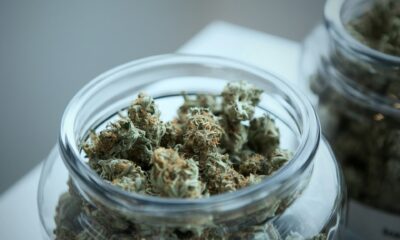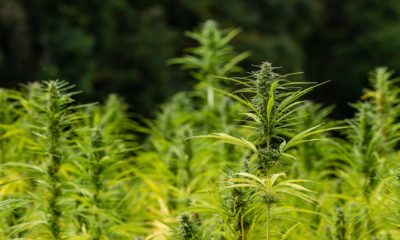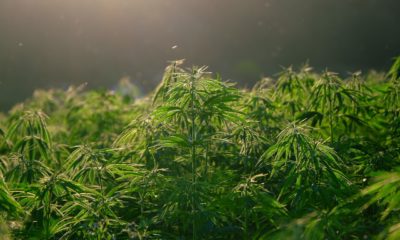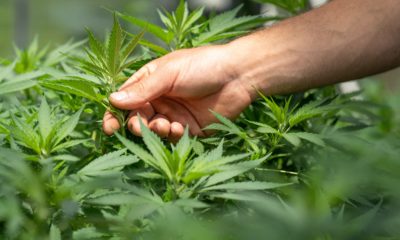Cannabis
Industrial Cannabis Production to be Promoted in Santa Fe
Last week, a bill was introduced in the Argentinian Chamber of Deputies that promotes the production of hemp and non-psychoactive cannabis derivatives for industrial and food purposes. The most immediate opportunities for Argentina would be -in addition to the medicinal area- in the hemp industry and an extensive series of cannabis derivatives with very low THC content.

The cannabis plant in the Republic of Argentina is slowly making its way so that all its uses are authorized and promoted. While in its medicinal or therapeutic aspect marijuana in Argentina is already socially, legally, and scientifically accepted -despite the fact that there are still many grey areas in its application-, there are still other aspects in which progress is still a pending debt of the State. One of these points is the social (or recreational) use of cannabis.
Read more on the subject and find the latest hemp news with the Hemp.im mobile app.
However, the use or exploitation of cannabis in its industrial and economic aspect is beginning to take its first steps in Santa Fe
Last week, a bill was introduced in the Chamber of Deputies that promotes the production of hemp and non-psychoactive cannabis derivatives for industrial and food purposes. With the aim of removing any stigmatizing view of the issue, the initiative highlights that hemp and non-psychoactive cannabis derivatives are considered to be seeds, plants, and their parts (stems, leaves, flowering tops, roots) of the species cannabis sativa L., as well as its extracts and products, containing up to a maximum concentration of psychoactive components of 1%.
According to the bill -drafted and presented by the deputy of the Equality block, Agustina Donnet- the enforcement authority of the law is the Ministry of Production, Science and Technology whose functions are to authorize and control the sowing, cultivation, storage, transport, industrialization, trade, import and export of hemp and non-psychoactive cannabis derivatives; to design and implement policies to promote the production of hemp and non-psychoactive cannabis derivatives for small and medium horticultural and rural producers, cooperative, associative, family, popular economy and native peoples; and to coordinate with national and provincial control and research organizations, such as Inta, Inase, Conicet, National Universities located in the province and public laboratories, the registration and study of genetic material and varieties of cannabis with properties of industrial, medical and scientific interest.
While in its medicinal or therapeutic aspect marijuana in Argentina is already socially, legally, and scientifically accepted -despite the fact that there are still many grey areas in its application-, there are still other aspects in which progress is still a pending debt of the State. The project seeks that the production of cannabis for industrial purposes be participatory through the implementation of specific policies of dissemination, technical advice, financing, and authorization for small and medium horticultural and rural producers and cooperative, associative, family, popular economy, and native peoples production.
Agroecological and sustainable hemp production
At the same time, agroecological and sustainable hemp production is proposed. It should promote the use of agroecological and environmentally sustainable forms of production, the application of appropriate technologies and the restriction of the use of agrochemicals, the respect for the natural and social diversity of local ecosystems, the diversification of crops and the revaluation of traditional practices. In the grounds of the bill, Congresswoman Donnet points out that “in recent years there has been an upward trend in the cannabis market, driven by the progressive loss of social prejudice against the plant, and the growing number of countries that enable its use for health purposes and regulate its production”. In this sense, Donnet refers to the document of the Council for Structural Change and the National Ministry of Productive Development called “The cannabis value chain: International situation and trends, and opportunities for Argentina”, published in March 2021. There it is highlighted that the expansion opportunities for the cannabis industry in our country are not limited to the medicinal and recreational market.
“Cannabis can be used for industrial purposes and in horticulture, to manufacture various derivatives (fibers, cosmetics, paper, construction materials, etc.), as well as food, beverages and infusions,” Donnet maintains, adding that “it is to be expected that in industries such as food, cosmetics and textiles, a significant expansion of the market for hemp and non-psychoactive cannabis derivatives will be observed.” Donnet argues that the United States “took a substantive step in this direction in 2018 by passing federal legislation enabling the cultivation of cannabis with less than 0.3% THC content. The imminent removal of obstacles to access to the banking system in the North Country’s legislation would also help faster development of the cannabis industry globally.”
According to this report, the most immediate opportunities for Argentina would be -in addition to the medicinal area- in the hemp industry and an extensive series of cannabis derivatives with very low THC content. There are not only opportunities for production projects, but also for research and development activities, both in the primary stage and in process improvements and new products.
Specifically, regarding horticultural production, the deputy states that “this production can be an alternative for diversification and job creation for some regional economies, including options for small producers and cooperatives, and can also give rise to indirect impacts towards industrial and service sectors”. There are numerous applications, more or less consolidated from a technical and market point of view, including cosmetics, textile fibers, clothing and footwear, biofuels, animal feed, construction materials, paper, fertilizers, automotive parts and bioplastics. It is worth noting that varieties of cannabis with very low psychoactive components can be used to make food, beverages and infusions. Seeds (with no or undetectable presence of CBD and THC) can be transformed into oils for applications in the food industry and beauty products. In turn, cannabis grain has 30 to 35% of oils with a high proportion of essential fatty acids, which gives it the potential to penetrate the edible oil market alone or combined with olive oil. Also, the remaining flours from oil extraction are high in protein, carbohydrates and fiber.
In the field of beverages, its inclusion in both alcoholic and non-alcoholic beverages is a business possibility that is already being explored by global industry giants. Cannabis production can be, in general, carried out outdoors (outdoor), in greenhouses (greenhouse) and indoors (indoor). In outdoor production, the plant grows in the field and is fed by sunlight; the conditions of its development are subject to the agronomic characteristics of the soil, in addition to the climatic phenomena that occur during the process. This type of production technique requires a significantly lower investment in infrastructure than the other alternatives.
Although the greater variability in the development of cannabinoids and a more heterogeneous production at the molecular level makes it less suitable when the production is for medicinal purposes, outdoor production is usually adequate for the aforementioned industrial purposes. According to the aforementioned studies, between 10 and 17 workers per hectare are required for outdoor production. Although the harvest stage is the one with the highest requirement of workers, the growth process is also accompanied by daily work that must be performed for the care of the plant. (Rubiano Moreno, 2019; PWC, 2019).
From the environmental point of view, it is worth noting that hemp presents negative carbon footprint, has low environmental impact, is soil remediating, and allows its rotation with other crops. From the legal perspective, the thresholds that distinguish between psychoactive and non-psychoactive cannabis vary from country to country; in Colombia and Uruguay, for example, the threshold is 1% THC content. Meanwhile, for the definition of hemp for industrial and horticultural use, values of less than 0.3% are usually taken in the United States and Canada and 0.2% in the European Union.
Controls on this plant were strengthened at the international level with the 1961 United Nations Single Convention on Narcotic Drugs, which included cannabis in Schedules I and IV, which group together highly addictive substances that are supposed to have little or no therapeutic value. In our country, cannabis was included in the first version of the Argentine Pharmacopoeia, enabling its medicinal use, but it was removed after the country adhered in 1963 to this Convention on Narcotic Drugs.
Since then, these substances have been subject to a series of strict controls limiting their production, trade and use. The Convention always explicitly authorized the cultivation of the cannabis plant exclusively for industrial (fiber and seeds) or horticultural purposes; however, in practice, its production was repressed in most of the world. For this reason, while in order to legalize medical cannabis markets, countries must establish control measures, implement a licensing system and supervise the production and distribution chain, in the case of cannabis for industrial purposes, the conventions do not require the creation of these special systems.
Currently, the Province of Santa Fe has many reasons to move forward with its own regulatory framework for this industry. In 2021, INTA carried out a horticultural census in our province: more than a thousand fruit and vegetable producers cultivate about 29 thousand hectares and provide direct and indirect labor to more than 70 thousand people. Historically, the province has been an exporter of vegetables to other provinces, mainly to the southern markets, and has a very diversified production that supplies more than 4 million consumers.
Cannabis production in Santa Fe
Regarding the proposal presented in the Santa Fe Legislature, the legislator pointed out that “the provincial State must assume a priority role in this issue of regulation and control, given the characteristics described of this sector, which, due to its legal status, requires strict control to avoid hidden psychoactive crops, the diversion of production to the clandestine chain, and the abuse of monopolistic actors.”
He added: “it must promote authorization, investments and access to inputs in the small and medium scale horticultural sectors, taking into account regional economies and the proximity link that the provincial management may have.”
__
(Featured image by TinaKru via Pixabay)
DISCLAIMER: This article was written by a third party contributor and does not reflect the opinion of Born2Invest, its management, staff or its associates. Please review our disclaimer for more information.
This article may include forward-looking statements. These forward-looking statements generally are identified by the words “believe,” “project,” “estimate,” “become,” “plan,” “will,” and similar expressions. These forward-looking statements involve known and unknown risks as well as uncertainties, including those discussed in the following cautionary statements and elsewhere in this article and on this site. Although the Company may believe that its expectations are based on reasonable assumptions, the actual results that the Company may achieve may differ materially from any forward-looking statements, which reflect the opinions of the management of the Company only as of the date hereof. Additionally, please make sure to read these important disclosures.
First published in AIREDIGITAL, a third-party contributor translated and adapted the article from the original. In case of discrepancy, the original will prevail.
Although we made reasonable efforts to provide accurate translations, some parts may be incorrect. Born2Invest assumes no responsibility for errors, omissions or ambiguities in the translations provided on this website. Any person or entity relying on translated content does so at their own risk. Born2Invest is not responsible for losses caused by such reliance on the accuracy or reliability of translated information. If you wish to report an error or inaccuracy in the translation, we encourage you to contact us.

-

 Crypto2 weeks ago
Crypto2 weeks agoAnalysts Warn Bitcoin’s Rally May Fade as MicroStrategy Signals Caution and Liquidity Weakens
-

 Fintech2 days ago
Fintech2 days agoItaly Issues First Natively Tokenized Minibond on Public Blockchain
-

 Cannabis1 week ago
Cannabis1 week agoUS Hemp Regulation Overhaul Sparks Global Impact
-

 Crowdfunding6 days ago
Crowdfunding6 days agoDigital Finance Fosters Inclusivity: Women and Minorities Lead in Italian Equity Crowdfunding
























